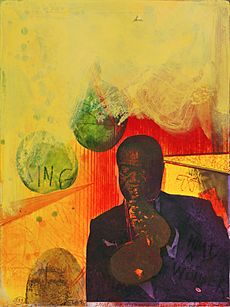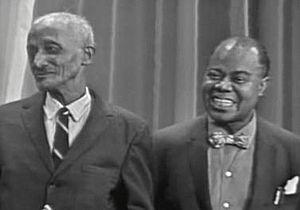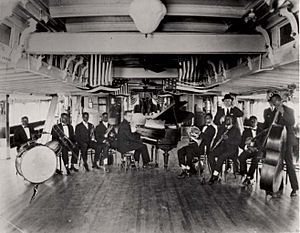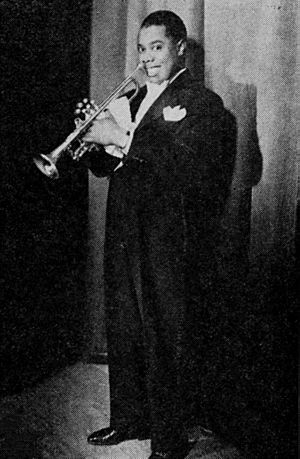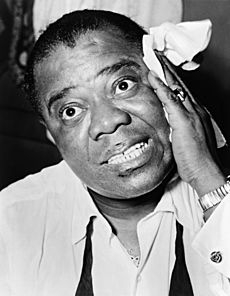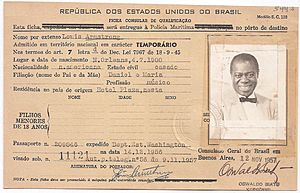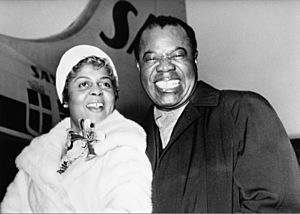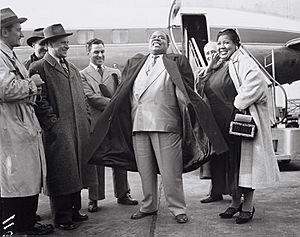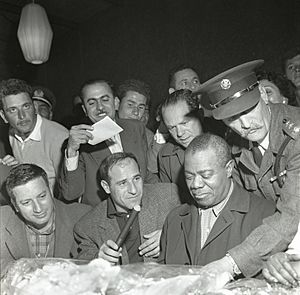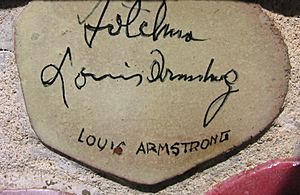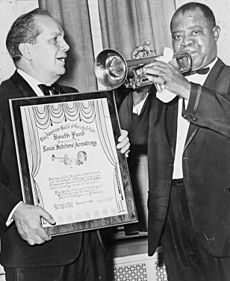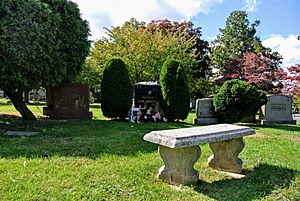Louis Armstrong facts for kids
Quick facts for kids
Louis Armstrong
|
|
|---|---|
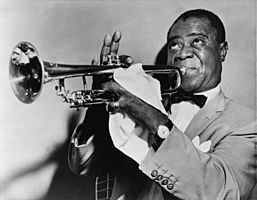
Armstrong in 1953
|
|
| Born |
Louis Daniel Armstrong
August 4, 1901 New Orleans, Louisiana, U.S.
|
| Died | July 6, 1971 (aged 69) New York City, U.S.
|
| Burial place | Flushing Cemetery |
| Other names |
|
| Education | Colored Waif's Home for Boys, Fisk School for Boys |
| Occupation |
|
| Spouse(s) |
Daisy Parker
(m. 1919; div. 1923)Alpha Smith
(m. 1938; div. 1942)Lucille Wilson
(m. 1942) |
| Children | 1 |
| Musical career | |
| Genres | |
| Instruments |
|
| Years active | 1919–1971 |
| Signature | |
 |
|
Louis Daniel Armstrong (born August 4, 1901 – died July 6, 1971) was a famous American trumpet player and singer. People often called him "Satchmo", "Satch", or "Pops". He was one of the most important people in jazz music. His amazing career lasted for five decades, covering many different periods of jazz history.
Armstrong was born and grew up in New Orleans. He became well-known in the 1920s as a creative trumpet and cornet player. He changed jazz by making solo performances more important than group playing. Around 1922, he moved to Chicago to play with his mentor, King Oliver. Later, he moved to New York City and became a very popular soloist and recording artist. By the 1950s, he was a national music star, appearing on radio, in movies, and on TV.
Some of his most famous songs include "What a Wonderful World", "La Vie en Rose", and "Hello, Dolly!". He also sang "On the Sunny Side of the Street" and "When the Saints Go Marching In". He worked with other great musicians like Ella Fitzgerald on albums such as Ella and Louis. Armstrong also appeared in many films, including High Society and Hello, Dolly!.
Armstrong had a unique, gravelly voice that was easy to recognize. He was a skilled singer and could improvise, changing the words and tune of a song. He was also great at scat singing, which is singing with nonsense syllables. Armstrong was one of the first African-American entertainers to become widely popular with white audiences around the world. He usually didn't talk much about politics, but he did speak out for desegregation during the Little Rock crisis.
Contents
Early Life in New Orleans
Louis Armstrong was born in New Orleans on August 4, 1901. His parents were Mary Estelle "Mayann" Albert and William Armstrong. Louis grew up in a very poor area called The Battlefield.
When he was about six years old, Louis lived with his mother and sister. He also worked for the Karnoffskys, a kind family of Lithuanian Jews. He helped their sons collect old items and deliver coal. In 1969, Armstrong wrote a book about his time with the Karnoffsky family. He said they taught him to sing "from the heart." They treated him very well, giving him food and support.
Armstrong wrote that the Karnoffskys faced unfair treatment from other white people because they were Jewish. He learned from them "how to live—real life and determination." He even started playing a tin horn to attract customers for their junk wagon. Morris Karnoffsky helped him buy his first cornet from a pawn shop. Armstrong wore a Star of David necklace for the rest of his life to remember this family.
When Armstrong was eleven, he stopped going to school. He joined a group of boys who sang on the streets for money. He also got into some trouble. On December 31, 1912, he was arrested and sent to the Colored Waif's Home. This home was strict, but it was where Armstrong really learned to play music.
At the home, Armstrong improved his cornet skills by playing in the band. Peter Davis, his first teacher, chose him as the bandleader. Because of his talent, the famous musician Kid Ory noticed him.
After leaving the home, Armstrong found a job playing music at a dance hall. He heard the early sounds of jazz from bands playing in places like Pete Lala's, where King Oliver performed.
Starting His Music Career
Learning on Riverboats
Early in his career, Armstrong played in brass bands and on riverboats in New Orleans. He joined the band of Fate Marable, which traveled on the steamboat Sidney along the Mississippi River. Marable taught Armstrong and other musicians to read music. Armstrong called his time with Marable "going to the University" because it taught him so much. In 1919, he took over King Oliver's spot in Kid Ory's band.
By the time he was twenty, Armstrong could read music well. He became one of the first jazz musicians to play long trumpet solos, adding his own unique style. He also started singing during his performances.
Moving to Chicago
In 1922, King Oliver invited Armstrong to move to Chicago. Playing second cornet in Oliver's Creole Jazz Band, Armstrong earned enough money to stop working other jobs. Oliver's band was very popular in Chicago.
Armstrong made his first studio recordings with Oliver in 1923. These early recordings were made by playing directly into a large funnel. Armstrong had to stand far away from Oliver because his playing was so loud!
Lil Hardin, who later became Armstrong's second wife, encouraged him to become a bigger star. She wanted him to develop his own style. She also helped him dress more stylishly.
Playing in New York
Armstrong and Oliver separated in a friendly way in 1924. Soon after, Armstrong was invited to New York City to play with the Fletcher Henderson Orchestra. This was the top African-American band at the time. He switched to the trumpet to fit in better with the other musicians.
Armstrong's emotional playing style influenced the other band members. His performances also included singing and telling stories. The Henderson Orchestra played in famous places for white audiences, like the Roseland Ballroom. Other great musicians, like Duke Ellington, came to watch Armstrong play.
During this time, Armstrong also recorded with blues singers like Bessie Smith.
The Hot Five and Hot Seven
In 1925, Armstrong went back to Chicago. His wife, Lil, wanted him to become even more famous. She called him "The World's Greatest Trumpet Player." He formed a group called Louis Armstrong and his Hot Five. They recorded popular songs like "Potato Head Blues".
The Hot Five usually had Kid Ory (trombone), Johnny Dodds (clarinet), Johnny St. Cyr (banjo), Lil Armstrong on piano, and no drummer. They made many records, and Armstrong's solos were very creative. His recordings with pianist Earl Hines, like "Weather Bird" and "West End Blues", are still considered some of the most important jazz improvisations ever. Young trumpet players learned from these recordings.
Armstrong was now free to create his own unique style. He started scat singing, which is singing with made-up sounds instead of words. He was one of the first to record scat singing on the Hot Five song "Heebie Jeebies" in 1926. This song was so popular that his group became the most famous jazz band in the U.S.
Becoming a Vocal Star
Harlem Renaissance Impact
Armstrong had a huge impact during the 1920s Harlem Renaissance. This was a time when African-American culture, especially art and music, became very popular. Famous writer Langston Hughes admired Armstrong and said he was one of the most recognized musicians of that time. Armstrong's music helped shape Hughes's writing.
Armstrong changed jazz during this period. His popularity brought together many black and white audiences.
Singing Takes Center Stage
Armstrong returned to New York in 1929. He performed in a musical called Hot Chocolates. He sang "Ain't Misbehavin'" and it became his best-selling record.
He started working at Connie's Inn in Harlem. Armstrong had great success with his vocal recordings. His 1930s recordings used new microphones that made voices sound warm. His version of "Stardust" became one of the most successful ever, showing off his unique voice and style.
Armstrong's singing style was very new and exciting. He would change melodies and add his own improvisations, just like he did with his trumpet. His deep, gravelly voice became famous and many other singers tried to copy it. His scat singing was also amazing because he was such a great trumpet player.
Working Through Tough Times
The Great Depression in the early 1930s made things hard for musicians. Many clubs closed, and many musicians stopped playing.
Armstrong moved to Los Angeles in 1930 to find new chances. He played at the New Cotton Club, where Hollywood stars would come to listen. Radio broadcasts from the club helped him reach younger audiences. In 1931, he appeared in his first movie, Ex-Flame.
He returned to Chicago, but then had to leave because of mob troubles. He visited New Orleans and was welcomed as a hero. He even had a baseball team named after him. After touring the country, he went to Europe for a while.
When he came back to the U.S., he had many problems, including money issues and lip damage from playing the trumpet so much. He hired Joe Glaser as his new manager, who helped him fix his legal and money problems. Armstrong started focusing more on his singing and acting. He appeared in movies like Pennies from Heaven. In 1937, he became the first African American to host a national radio show.
Later Career and Fame
The All Stars Band
After many years of touring, Armstrong settled down in Queens, New York, in 1943 with his fourth wife, Lucille. Big bands became less popular in the 1940s. So, Armstrong decided to go back to playing with a smaller group, like he did when he was younger.
On August 13, 1947, his manager, Joe Glaser, changed Armstrong's big band into a six-piece traditional jazz group. This new group was called Louis Armstrong and His All Stars. It included other top jazz musicians like Earl Hines and Jack Teagarden.
In 1950, he recorded the American version of the French song "C'est si bon", which became a worldwide hit. In 1949, he was the first jazz musician to be on the cover of Time magazine. For over 30 years, Armstrong played more than 300 shows a year, made many recordings, and appeared in over thirty films.
A Jazz Ambassador
By the 1950s, Armstrong was a beloved American icon and a cultural ambassador around the world. He toured places like Ghana and Nigeria.
In 1964, after two years away from the studio, he recorded his biggest-selling song, "Hello, Dolly!". This song went to No. 1, making him, at 62 years old, the oldest person to have a number one song. His hit even knocked The Beatles off the top of the charts!
Armstrong continued to tour even in his 60s, visiting countries in Europe, Africa, and Asia. The U.S. government sponsored some of these tours, earning him the nickname "Ambassador Satch." By 1968, his health was getting worse. He had heart and kidney problems, which forced him to stop touring. He spent most of 1969 resting at home.
Armstrong's last recorded trumpet performances were on his 1968 album Disney Songs the Satchmo Way.
Personal Life
His Name
Armstrong sometimes said that white people called him "Louie." On some live recordings, you can hear people call him "Louie" on stage. "Lewie" is the French way to say "Louis" and is common in Louisiana.
Family Life
Armstrong married Daisy Parker in 1919. They adopted a three-year-old boy named Clarence, whose mother, Armstrong's cousin, had died. Clarence had a mental disability from a head injury, and Armstrong took care of him for the rest of his life. Louis and Daisy separated in 1923.
In 1924, he married Lil Hardin Armstrong, who was King Oliver's pianist. She helped him grow his career. They separated in 1931 and divorced in 1938. Armstrong then married Alpha Smith, but they divorced in 1942. Finally, Louis married Lucille Wilson, a singer, in October 1942. They stayed married until he died in 1971.
Armstrong did not have any children from his marriages. However, in 2012, a woman named Sharon Preston-Folta said she was his daughter from another relationship.
Personality and Beliefs
Armstrong was a very colorful and charming person. He loved to tell stories, especially about his childhood. He was loved by the American public. He was able to have a good life even though it was difficult for many African Americans at that time.
He usually stayed out of politics. However, he did criticize President Eisenhower for not doing enough to support civil rights during the Little Rock crisis in 1957. As a protest, Armstrong canceled a planned tour to the Soviet Union. He said he couldn't represent his government when it was treating its own people unfairly. The FBI even kept a file on him because he spoke out about integration.
Health and Habits
Playing the trumpet was very hard on Armstrong's lips. He suffered from lip damage for most of his life because of his playing style. He used special creams and even cut off scar tissue with a razor blade.
In 1959, Armstrong was hospitalized for pneumonia while touring in Italy. Doctors were worried about his lungs and heart.
Nicknames Explained
The nicknames "Satchmo" and "Satch" are short for "Satchelmouth." One story says that as a boy in New Orleans, he would put coins in his mouth to stop other kids from stealing them. So, people called him "satchel mouth." Another story is that his mouth was simply very large.
He was also known as "Dipper" or "Dippermouth" early on.
The nickname "Pops" came from Armstrong's habit of calling other people "Pops" when he forgot their names. Eventually, people started calling him "Pops" too.
Religion
When asked about his religion, Armstrong said he was raised a Baptist, always wore a Star of David, and was friends with the pope. He wore the Star of David to honor the Karnoffsky family who helped him as a child.
Writing and Hobbies
Armstrong loved to write. He would constantly type or write letters to friends around the world. He shared stories about his music, food, and childhood memories.
He was also a big fan of baseball. He even started a baseball team in New Orleans called Armstrong's "Secret Nine."
His Music Style
Trumpet Playing and Jazz Innovation
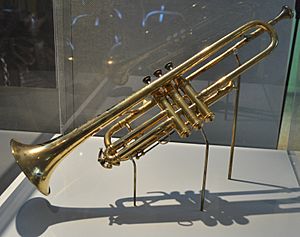
In his early years, Armstrong was famous for how well he played the cornet and trumpet. He was known for his strong rhythm and how he could play high notes. His recordings with the Hot Five and Hot Seven are especially praised.
Before Armstrong, jazz bands mostly played the main tune of songs together. Armstrong was one of the first to create new variations based on the chords of the songs, not just the melody. This made jazz more about individual soloists. He changed jazz from a group folk music into an art form where musicians could express themselves.
Armstrong also used recordings to get better at his music. He had a huge collection of recordings and would listen to his own performances to improve.
Vocal Popularity
As Armstrong's music grew, his singing became very important. He was a master of scat singing and helped make it popular. On one recording session, the sheet music supposedly fell, and he just started singing nonsense syllables. That version became a hit!
Armstrong would play around with his vocals, changing phrases and adding improvisations. His unique, gravelly voice was copied by many other singers.
Composing Songs
Armstrong was also a talented composer. He wrote more than fifty songs. Some of them, like "Gully Low Blues" and "Potato Head Blues," became well-known jazz standards.
Working with Other Musicians

Throughout his long career, he played and sang with many important musicians. These included Bing Crosby, Duke Ellington, Ella Fitzgerald, and Bessie Smith. Bing Crosby, a very successful singer, admired and copied Armstrong's style.
Armstrong recorded two famous albums with Ella Fitzgerald: Ella and Louis and Ella and Louis Again.
His albums Louis Armstrong Plays W.C. Handy (1954) and Satch Plays Fats (1955) are considered masterpieces. In 1961, he made two albums with Duke Ellington.
Later Hits
Armstrong had nineteen songs that reached the "Top Ten" on the music charts. These included "Stardust", "What a Wonderful World", and "Hello, Dolly!". His song "We Have All the Time in the World" was in a James Bond movie and became popular again in the UK.
In 1964, "Hello, Dolly!" made him the oldest artist to have a number one song in the U.S. In 1968, "What a Wonderful World" topped the British charts. He even appeared on The Johnny Cash Show in 1970.
Musical Range
Armstrong enjoyed many types of music, from blues to classical. He used influences from all these styles in his performances. He was inducted into the Rock and Roll Hall of Fame as an "early influence."
Movies, TV, and Radio
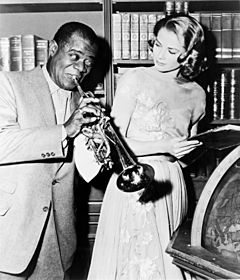
Armstrong appeared in more than a dozen Hollywood movies. He usually played a bandleader or musician. His most famous movie role was in the 1956 musical High Society, where he sang with Bing Crosby. In the 1959 film The Five Pennies, he played himself and sang with Danny Kaye. He also had a part in The Glenn Miller Story.
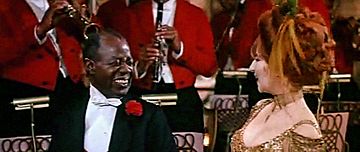
In 1937, Armstrong was the first African American to host a national radio show. In 1969, he had a small role in the movie Hello, Dolly! with Barbra Streisand. He also appeared on TV shows like The Tonight Show Starring Johnny Carson.
Death
Louis Armstrong played a two-week show in March 1971, even though his doctor advised against it. After the show, he was hospitalized for a heart attack. He died of a heart attack in his sleep on July 6, 1971, at his home in Corona, Queens, New York City. He was buried in Flushing Cemetery in Queens.
Many famous people were honorary pallbearers at his funeral, including Bing Crosby, Ella Fitzgerald, Dizzy Gillespie, and Frank Sinatra.
Awards and Honors
Grammy Awards
Armstrong received the Grammy Lifetime Achievement Award in 1972 after he passed away. This award honors performers who have made huge artistic contributions to recording.
| Year | Category | Title | Genre | Label | Result |
|---|---|---|---|---|---|
| 1964 | Male Vocal Performance | "Hello, Dolly!" | Pop | Kapp | Winner |
Grammy Hall of Fame
Many of Armstrong's recordings have been added to the Grammy Hall of Fame. This award honors recordings that are at least 25 years old and are very important historically or artistically.
| Year recorded | Title | Label | Year inducted | Notes |
|---|---|---|---|---|
| 1925 | "St. Louis Blues" | Columbia | 1993 | With Bessie Smith |
| 1926 | "Heebie Jeebies" | OKeh | 1999 | |
| 1928 | "West End Blues" | OKeh | 1974 | |
| 1928 | "Weather Bird" | OKeh | 2008 | With Earl Hines |
| 1955 | "Mack the Knife" | Columbia | 1997 | |
| 1964 | "Hello, Dolly!" | Kapp | 2001 | |
| 1967 | "What a Wonderful World" | ABC | 1999 |
Other Inductions and Honors
- In 1995, the U.S. Post Office issued a Louis Armstrong postage stamp.
- He was inducted into the DownBeat Jazz Hall of Fame in 1952.
- He has a star on the Hollywood Walk of Fame.
- He was inducted into the Rock and Roll Hall of Fame in 1990 as an "early influence."
His Amazing Legacy
Armstrong's influence on jazz music is huge. His strong personality as a performer sometimes overshadowed his musical contributions.
As a trumpet player, Armstrong had a unique sound and an amazing talent for creating new melodies on the spot. Because of him, the trumpet became a very important solo instrument in jazz. He changed jazz from a group music into an art form for individual expression. He was also a great musician when playing with a group. His new ideas raised the bar for all musicians who came after him.
Even though Ethel Waters recorded scat singing before him, Armstrong was a master at it and helped make it popular. Many famous singers, like Billie Holiday and Frank Sinatra, were inspired by him. Duke Ellington said, "If anybody was a master, it was Louis Armstrong. He was and will continue to be the embodiment of jazz."
In 1991, an asteroid was named 9179 Satchmo in his honor. In 2001, New Orleans' main airport was renamed Louis Armstrong New Orleans International Airport. The US Open tennis stadium was also named Louis Armstrong Stadium because he lived nearby.
Louis Armstrong Park in New Orleans, which includes a statue of Armstrong, was dedicated in 1980. The house where Armstrong lived for almost 28 years is now the Louis Armstrong House Museum. It is a National Historic Landmark and offers concerts and educational programs.
Many people believe Louis Armstrong is one of the greatest American artists ever.
Discography
See also
 In Spanish: Louis Armstrong para niños
In Spanish: Louis Armstrong para niños
- Ella Fitzgerald and Louis Armstrong collaborations


